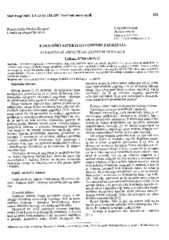Приказ основних података о документу
Etiological aspects of anterior open bite
Etiološki aspekti otvorenih zagrižaja
| dc.creator | Stojanović, Ljiljana | |
| dc.date.accessioned | 2020-07-02T12:16:03Z | |
| dc.date.available | 2020-07-02T12:16:03Z | |
| dc.date.issued | 2007 | |
| dc.identifier.issn | 0025-8105 | |
| dc.identifier.uri | https://smile.stomf.bg.ac.rs/handle/123456789/1367 | |
| dc.description.abstract | Introduction. Open bite is a multifactorial phenomenon and no single factor can account for open-bite. Etiology plays an important role in diagnosis. Heredity, unfavorable growth patterns, incorrect jaw postoure, are the characteristics of skeletal open bite. Digit sucking. Depending on where the thumb is placed, a number of different types of dental problems can develop. Malocclusions of the late mixed or permanent dentitions, caused by thumb sucking are not self corrected and orthodontic treatment is necessary for their correction. Lymphatic tissue. In order to produce oral respiration, the mandible is postured inferiorly with the tongue protruded and resting against the oral floor. This postural alteration induces dental and skeletal modifications similar to those caused by thumb sucking. This may cause excessive eruption of the posterior teeth, leading to an increase in the vertical dimension of the face and result in development of anterior open bite. Tongue thrust. Tongue habits cause an anterior open bite or they develop secondarily to thumb sucking. In skeletal open bite the tongue habit acts as a secondary factor which helps to maintain or exacerbate the condition. Many orthodontists have had a discouraging experience of completing dental treatment, with what appeared to be good results, only to discover that the case had relapsed because the patient had a tongue thrust swallowing pattern. Conclusion. Dentoalveolar or habitual open bite is caused by habits, which influence the growth and development of dentoalveolar processes and contribute to occlusal disharmonies. Prior to eruption of adult dentition, open bite related to oral habits is usually not a concern as when the habits stop, because the erupting dentition tends to improve spontaneously. Treatment is usually not necessary until permanent teeth erupt (~6 years old). . | en |
| dc.description.abstract | Problem dijagnostike i diferencijalne dijagnoze različitih tipova otvorenih zagrižaja usko je povezan sa etiološkim faktorima, koji imaju višestruku ulogu: učestvuju u formiranju same malokluzije; kada se otkriju na samom početku terapije, uveliko se izbegavaju terapijske greške, koje ako su učinjene na početku, mogu pogoršati i iskomplikovati kliničku sliku same anomalije, otežati lečenje i dovesti u pitanje ishod; ujedno su i vrlo čest uzrok recidiva, koji predstavlja ozbiljan problem kada je u pitanju ova vertikalna displazija. . | sr |
| dc.publisher | Društvo lekara Vojvodine Srpskog lekarskog društva, Novi Sad | |
| dc.rights | openAccess | |
| dc.source | Medicinski pregled | |
| dc.subject | open bite + etiology | en |
| dc.subject | malocclusion + etiology + diagnosis | en |
| dc.subject | otvoreni zagrižaj + etiologija | sr |
| dc.subject | malokluzija + etiologija + dijagnoza | sr |
| dc.title | Etiological aspects of anterior open bite | en |
| dc.title | Etiološki aspekti otvorenih zagrižaja | sr |
| dc.type | article | |
| dc.rights.license | ARR | |
| dcterms.abstract | Стојановић, Љиљана; Етиолошки аспекти отворених загрижаја; Етиолошки аспекти отворених загрижаја; | |
| dc.citation.volume | 60 | |
| dc.citation.issue | 3-4 | |
| dc.citation.spage | 151 | |
| dc.citation.epage | 155 | |
| dc.citation.other | 60(3-4): 151-155 | |
| dc.identifier.doi | 10.2298/MPNS0704151S | |
| dc.identifier.scopus | 2-s2.0-35548981297 | |
| dc.identifier.fulltext | https://smile.stomf.bg.ac.rs/bitstream/id/203/1362.pdf | |
| dc.type.version | publishedVersion |


